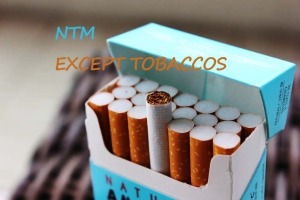NTM – Except Tobaccos
The 6 kinds of paper in a cigarette pack

Paper in a Cigarette Pack
A cigarette pack is tiny and delicate. But it is formed by many units via complex making processes.
For example, do you know the cigarette butt and the cigarette are bonded by glue?
This article is about the paper materials used in a cigarette pack. Let’s count how many kinds of paper are indeed in it.
- Heat Sealable Package BOPP Films for Cigarette Overwrap

BOPP Film Cigarette Pack
This layer of packaging film is the transparent cellophane on the outermost part of the cigarette box.
It is not actually paper in the true sense, but in China, we call it “plastic paper” in popular terms. That’s why I list this item in the first place.
The transparent paper is made of biaxially oriented polypropylene film, also known as BOPP film.
It is produced through a process called biaxial orientation, where the film is stretched in two directions, both lengthwise and widthwise. This stretching process enhances the film’s mechanical properties, such as strength, clarity, and moisture barrier properties.
Sometimes when we open the package or box, we feel that the outer plastic paper is difficult to tear off. Yes, it is the BOPP film that makes you very distressed!
- Cardboard Paper

Cardboard Paper
Packaging box paper is generally white cardboard; some specialty paper is pearlescent paper, and some are matte powder paper.
It is a type of thick paperboard that provides structural support and protection to the cigarettes inside.
Cardboard paper is typically made from multiple layers of paperboard, often with a middle layer called corrugated or fluted medium sandwiched between two outer layers. This construction gives the cardboard its strength and rigidity. The outer layers, or linerboard, are usually made from high-quality paper pulp, while the middle layer adds cushioning and reinforcement.
It is designed to withstand handling, transportation, and storage while keeping the cigarettes secure and protected until they are opened by the consumer.
What’s more, for the anti-counterfeiting of cigarette packs, a lot of process treatments will be done, such as indentation treatment, laser, bronzing, matte lamination, and other surface treatments.
- Inner Aluminum Foil

Inner Aluminum Foil
Ordinary soft packs or hard packs are mainly wrapped with aluminum foil paper, mainly laminated aluminum foil paper and aluminized paper.
It is placed between the inner cardboard layer and the cigarettes themselves.
The aluminum foil serves multiple purposes in a cigarette pack:
- Protection: It acts as a moisture barrier, preventing moisture from entering the pack and affecting the quality and freshness of the cigarettes.
- Aroma preservation: The aluminum foil helps to retain the distinctive aroma of the tobacco, ensuring that the cigarettes maintain their intended scent.
- Heat reflection: The foil reflects heat, which can help in reducing the risk of accidental fires caused by improper disposal of lit cigarettes.
- Product integrity: The foil provides an additional layer of protection for the cigarettes, preventing damage or crushing during handling and transportation.

Plug Wrap Paper
Plug wrap paper is the paper used to wrap the cigarette mouth stick. When you cut the part of the cigarette mouth stick, you will see the tow fiber and the thin paper on the outermost layer.
This kind of paper is highly required in breathable and waterproof. For ventilation, the paper is usually filled with fine pinholes, and this layer of paper is between the tipping paper and the filter.

Tipping Paper Bobbin
Tipping paper, also known as cigarette tipping paper or filter tipping paper, is a specialized type of paper used in the production of cigarettes. It is primarily used to create the mouthpiece or filter end of a cigarette.
Tipping paper is typically made from a combination of wood pulp and various additives, such as calcium carbonate, adhesive materials, and flavorants. It is designed to be porous to allow the passage of air and smoke, while also providing a comfortable and hygienic surface for the smoker’s lips.
The purpose of tipping paper goes beyond functionality. It also serves as a branding and decorative element, featuring logos, brand names, designs, or warning messages. Tipping paper plays a role in distinguishing different cigarette brands and enhancing the overall visual appeal of the cigarette pack.
Additionally, tipping paper may undergo special treatments, such as applying burn additives or flavorings, to influence the smoking experience. These treatments can affect the burn rate, flavor, or aroma of the cigarette when it is lit.
In summary, tipping paper is a specialized paper used to create the filter end of a cigarette, providing functionality, branding, and potential flavor enhancements.
Cigarette paper is the paper that wraps shredded tobacco.
Cigarette paper is made of natural fibers such as hemp pulp or wood pulp and fillers such as calcium carbonate, and a small number of additives are also added, while ordinary paper is mainly made of wood pulp.
Cigarette paper can be divided into marking cigarette paper and non-marking cigarette paper. The lines on marking cigarette paper can be horizontal (Verge) or vertical (Repse). Their main function is to improve the appearance and increase the air permeability.
Now with the development of cigarette technology, not only the color of tipping paper has been diversified, but also cigarette paper is full of personality.
A cigarette is not only different in thickness, but also in length, and the rib of the cigarette paper is also varied.
Can you tell how many kinds of paper a cigarette uses now?


 "Pack of Cigarettes" by lindsay-fox is licensed under CC BY 2.0.
"Pack of Cigarettes" by lindsay-fox is licensed under CC BY 2.0.
 "Packs of Cigarettes of Different Brands with Warning Signs and Pictures as Creative Wall Decoration" by wuestenigel is licensed under CC BY 2.0.
"Packs of Cigarettes of Different Brands with Warning Signs and Pictures as Creative Wall Decoration" by wuestenigel is licensed under CC BY 2.0.
